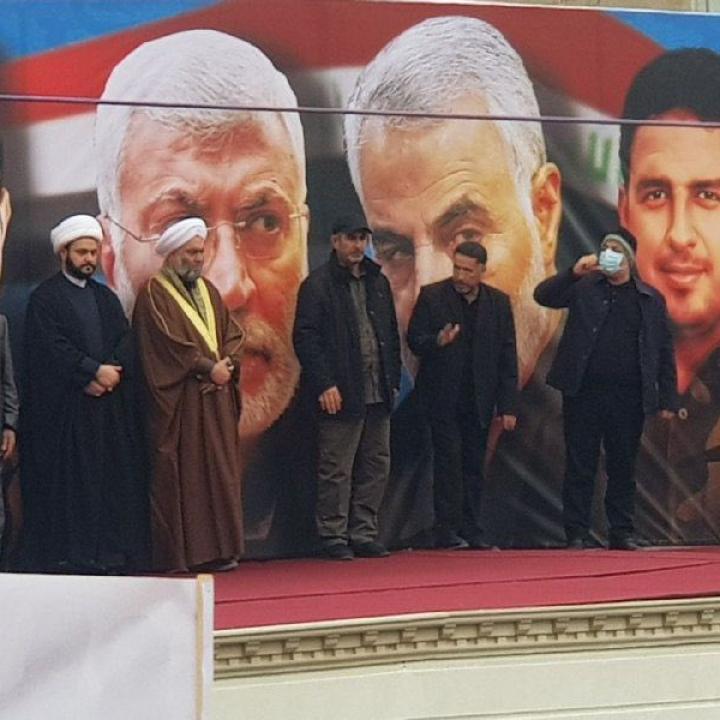
Muhandis Replaced by Not One Man, But Two?

Abu Fadak and Akram Kaabi seem to have inherited the PMF and "resistance" parts of the late militia leader's portfolio.
Two years after the death of Abu Mahdi al-Muhandis, the lines of succession for Iran-backed militias in Iraq are becoming clearer. Muhandis arguably served two main roles: as vice chairman and operational commander of the Popular Mobilization Forces (PMF), and as the senior Iraqi representative of Iran's Islamic Revolutionary Guard Corps-Qods Force (IRGC-QF). Today, however, these roles are apparently divided, with Kataib Hezbollah (KH) member Abu Fadak (Abdul-Karim al-Zrejawi) acting as PMF operational commander since February 2020, and Akram Kaabi, the founder of Harakat Hezbollah al-Nujaba, aspiring to lead the muqawama (resistance).
Abu Fadak's First Two Years as PMF Leader
Abu Fadak is not a naturally outgoing person in public settings—after a career in the shadows with KH, he has taken some time to adapt to overtly serving as de facto head of a large government-supported paramilitary force. Yet the majority of his power plays are still conducted in the shadows, and they increasingly resemble the consolidation strategy that Muhandis, one of his mentors, was beginning to impose on the PMF before his death.
Muhandis built the Amn al-Hashd (PMF Central Security Directorate) as an internal control mechanism to increase discipline and cement his hold over various PMF factions. Abu Fadak has seized control of the same security arm and also a range of KH-manned PMF special forces such as Unit 101 and Unit 313. He has also shown himself to be a canny and effective political operator within the KH pantheon, manipulating votes on the group's internal consultative council in order to undermine rival members such as Abu Hussein (Ahmad Mohsen Faraj al-Hamidawi), the commander of KH special operations. During a July 27 session, Abu Fadak conspired to formally remove Abu Hussein as KH secretary-general, though the issue apparently remains in the air.
Most recently, Abu Fadak has trained his sights on the Atabat, the "shrine units" who have opposed his appointment as PMF operational chief since February 2020. He is conniving to split up the largest of these units, al-Abbas Combat Division (Firqat al-Abbas al-Qitaliyah, the PMF's 26th Brigade), which like the others is affiliated with Ayatollah Ali al-Sistani.
Kaabi's Quiet Effort to Lead the "Resistance"
The other main role played by Muhandis—as the top representative of the IRGC-QF and, by extension, Iranian interests—has arguably been taken over by Akram Kaabi. As the Militia Spotlight team noted in an October 2021 article published by the West Point Combating Terrorism Center, the IRGC-QF probably selected Kaabi for this role as early as his January 2020 visit to Iran after Muhandis was killed.
Since then, Kaabi has only sent deputies ("jihadist assistants") to meetings that his former contemporaries—Hadi al-Ameri, Qais al-Khazali, and others—attended in person. Kaabi's selection seems logical given his dedicated service to the IRGC-QF in Iraq and Syria, as well as his propensity for keeping his relatively small Nujaba movement focused on resistance activities rather than politics and commercial interests. Whatever the case, his elevation has been deeply humiliating for his former boss Khazali, who aspired to outshine him. Another strong indicator of Tehran's support came when Kaabi delivered a speech on December 9, 2021, while standing in front of resistance flags that excluded KH and Asaib Ahl al-Haq. Apparently, IRGC-QF leader Esmail Qaani participated in the event and attentively listened to Kaabi's remarks.
Themes and Ideas for Analysts to Watch
Abu Fadak and Kaabi have some rivals in common: one is Abu Hussein, who challenges Abu Fadak in the KH realm and challenges Kaabi and the IRGC-QF in controlling resistance activities. Other shared rivals include the brothers Qais and Laith al-Khazali—they do not want to reined in by Abu Fadak or Kaabi, who are seemingly supported by most Iran-backed elements in Iraq. Like Abu Hussein, they may believe the Fadak-Kaabi axis is placing other objectives (e.g., PMF consolidation, Iranian foreign policy) over the resistance agenda.
Abu Fadak's control over the Amn al-Hashd also underlines the fact that there is no clean dividing line between PMF and resistance activities. His coercive machinery is seemingly beginning to apply rules to how, when, where, and by whom some resistance activities are undertaken, including what drones are used in specific operations. In many cases, efforts to publicly distance militia units from resistance operations merely underline the extensive overlap between PMF and muqawama networks while revealing their foreknowledge of each other's activities. Furthermore, some of Abu Fadak's forces—such as Unit 101—may play an integral role in regulating what targets are hit by muqawama actions (specifically convoy attacks), according to certain criteria. In short, Abu Fadak and Kaabi's empires are cooperating on resistance activities, albeit to shape the campaign in ways intended to meet IRGC-QF approval and cause less damage to the PMF's claims of being a legitimate government institution.







